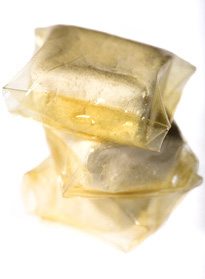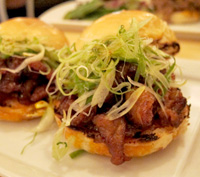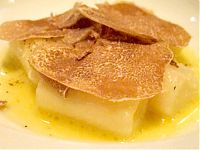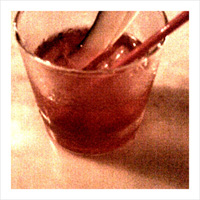
New American Cuisine
by Celia Sin-Tien Cheng
October 31, 2007
My year so far has been one of remarkable discoveries in American culinary excellence. Besides the constantly changing culinary landscape of New York, I’ve relished the tastes from top chefs in Portland, Honolulu and Washington D.C. However, the most eye-opening experience was my recent trip to Chicago. Whatever has inspired the chefs in the Windy City to produce the most innovative and exquisite cuisine in America, I don’t know, but I hope it continues and spreads to the rest of the country because this Chicago phenomenon is truly unparalleled.
The three highlights I’ll share in this month’s feature are Alinea, Green Zebra and Sepia. Though all three restaurants serve modern American fare, they are stylistically unique in their approach and mission.
When asked, “What exactly is contemporary American cuisine?” I am pressed for an adequate answer. For me, it’s what good chefs are doing here in America, compounding their fine training, whatever the origins, with their personal sense and interpretation to create their own cuisine. It’s not fusion, though the ingredients and influences may be international, but it’s understanding the composition of food, its ingredients, tastes and properties, to create new flavor profiles that work. Hence the difficulty pinpointing exactly what that is, since each chef’s style varies.
I don’t often try to define “new American cuisine,” but this Chicago excursion really got me thinking about it. And it has also given me the opportunity to showcase the best in class. Bravo, Chicago! And bravo, Alinea, Green Zebra, and Sepia!

New American Cuisine
by Celia Sin-Tien Cheng
October 31, 2007
ALINEA
1723 N Halsted St
Chicago, IL 60614
312-867-0110
Alinea is perfectly conceived in every way. The name itself sounds beautiful and is meaningful, too; it’s the name of the typographic symbol that denotes a new train of thought (¶). And Alinea, in its unprecedented design, seamless execution and acute attention to detail, represents a very welcome new train of thought in contemporary American cuisine.
To say that chef-owner Grant Achatz is talented is an understatement. His genius lies in the cumulative understanding of dining as art, science, innovation and curiosity. While he is often referenced at the forefront of molecular gastronomy, Achatz, to my relief, disassociates himself from that reference. He is an artist who strives for excellence, not a mad scientist, using chemistry only to achieve his artistic vision. He does not manipulate food just for the sake of altering its properties, and he doesn’t compromise the form or taste for playfulness. Inspired by Ferran Adria’s postmodern cooking at El Bulli in Spain, this influence manifests itself in Achatz’s own unique progressive style. Be assured, though, that modernity never takes the place of elegance at Alinea; all is balanced.
Dining at Alinea is an “experience” — not just a meal — that begins the moment you step through the doors into this spectacular space. First, the eye is drawn straight ahead to the floating glass and metal staircase that leads to the dining rooms upstairs. From the same vantage point, to the left is a small dining room, and on the right, in plain view, is the immaculate open kitchen. The transparency of the kitchen at the entrance of the restaurant comes as a bit of a shock, as I expected the execution of the cuisine to be somewhat of a mystery, but the decision to disclose the action is a quite appropriate display of total confidence. There is a steady stream of movement and energy all about the kitchen, from the point of entry and exit and surging deep within. A big part of dining is the rhythm of the experience. Sitting in the dining room across from the kitchen, I could observe all the action, but the staff at Alinea made it look easy — that in itself is an art.
Once seated, guests are offered a choice of two degustation menus: the twelve-course “tasting” ($135) or the twenty-seven-course “tour” ($195). While both sound excessive, each course is either bite-sized or precisely designed to offer a taste of intricate flavors rather than fill you up. Wine pairing from a wonderfully diverse list is also available.

The design of the serving ware is as precise as the food itself. For the first course of the tour this evening, a piece of duck topped with banana pudding and Thai herbs was placed meticulously on a fork that sat across the bowl over the butternut squash soup with banana froth within (see photo above). The waiter very seriously asked that I not place the bowl on the table but to eat the duck first, then lay the fork on the piece of glass that had been placed on the table to hold it. Finally, after finishing the soup, I could set the bowl on the table. There is a methodology for consuming each item presented. The waiter’s instructions are important, as it is often not obvious how to eat the items in any graceful manner.
I’ll share a couple of my favorites.
The kuroge Wagyu (Kobe beef) with matsutake panade and yuzu pudding was served in a bowl completely covered by cedar branches. I couldn’t see the contents underneath, except for a single silver pin sticking out of the leaves. Apparently, matsutake mushrooms grow under cedar trees, which was the inspiration for this “piece.” It was so poetic, and the aroma of the cedar branches was an integral part of the experience of the dish. I was instructed to simply pull out the pin that holds the beef and mushroom panade. Voilà! And in a single bite, it was gone, as the seared cube of marbled meat melted in my mouth.
One of the most interesting dishes was apple cider encapsulated in a cinnamon shell. The sphere, made by dipping frozen cider in cinnamon-infused cocoa butter, sat in a glass of walnut milk. I was asked to drink it in one gulp but to pay attention to the fact that the sphere looked smaller in the glass than it actually was. Once the sphere broke open in my mouth, the cider and cocoa butter mixed with the walnut milk to create a burst of refreshing and wonderfully combined flavors.
The hot potato/cold potato (see photo at the top of the page) was my favorite dish! The black truffle, hot potato ball, butter, parmesan and chive on a pin was a miniature sculpture unto itself, so beautiful that I didn’t want to destroy it. Nevertheless, I slid the pin out of the dish, watching the hot contents drop into the cold potato soup, and then I drank it in one gulp. I love potatoes, but regardless of my bias, this dish is perfectly balanced in flavor and so well orchestrated!

About halfway through the tour, I was served a single piece of pineapple candy with bacon powder and black pepper (photo above). The clear pineapple leather wrapped around a soft, chewy bacon and pepper candy that looked like a marshmallow but is made with bacon fat, black pepper mixed with sugar and maltodextrin. The flavors complemented each other, though the pineapple leather kind of stuck to my teeth like fruit rollups.

A “frozen pumpkin pie” made a grandiose entrance as the finale to the meal. The frozen filling encrusts a brown sugar pâte de fruits center and is then deep-fried tempura style. It was served in specially designed pronged setting pieces (see photo above). Smoldered leaves were attached to the “pie”, so the branch acts as your utensil as you pick it up to eat the pie. I couldn’t think of a more dramatic or more delicious way to end the meal. I was in awe! My senses had been challenged and though I was full, I craved more.
There is no one in America doing what Chef Achatz is doing at Alinea: pushing the limits of our imagination beautifully and tastefully! Gourmet named Alinea the number one restaurant in America in 2005, but I think what counts more is the thought that, upon leaving the restaurant, customers are forever changed and understand what truly evolved dining is.
All I can say is thank you!
Note: Chef Grant Achatz was diagnosed with advanced squamous cell carcinoma (skin cancer) of the mouth this summer and has been receiving medical treatment. Our thoughts go out to Chef Achatz, and we wish him a full recovery.

New American Cuisine
by Celia Sin-Tien Cheng
October 31, 2007
GREEN ZEBRA
1460 W Chicago Ave
Chicago, IL 60642
312-243-7100
Despite what my mother may think — which is that vegetarianism will be the next big thing — when most carnivores hear the words “vegetarian restaurant,” the tendency is to retreat rather than venture forth. But Green Zebra, a vegetarian-focused small plates restaurant, shows carnivores just how good vegetarian cuisine can be.
Named after the beautifully striped green heirloom tomatoes (see photo above), Green Zebra is more than three years old, but the vibe and concept of the restaurant is a breath of fresh air. The menu’s emphasis is on seasonality and creativity. The dishes are scrumptious, and since it’s all small plates, you can try a variety of them. The ingredients and produce are fresh and the dishes concocted, rich or simple, are always flavorful.
I was attracted to the evening’s fall harvest tasting menu, which consisted of roasted spaghetti squash, curried cauliflower soup, celery root beignet, tagliatelle, and brioche donut. My friend ordered the fresh burrata cheese Niçoise, sweet onion soup, sweet potato tart, and truffle risotto. Between the two of us, we got a pretty good grasp on the spectrum of chef Shawn McClain’s inventive vegetarian cuisine.
Here are two highlights from the meal:
The burrata cheese Niçoise salad with haricot vert, a sliver of anchovy, quail egg halves and caper berry was amazing. There’s been a big burrata — fresh mozzarella with a softer mozzarella and cream-based core — craze this year, but most of what I’ve tasted at restaurants has not done the cheese justice. It must be extremely fresh to retain its delicate creaminess, and Green Zebra has gotten it right. While the quintessential salade Niçoise elements are present in this dish, they are sparingly interspersed so as not to overwhelm the burrata with too much flavor; they accent the cheese with just the right amount of aroma and finesse. This is a truly elegant dish that I want to revisit over and over.
Another favorite from the meal was the sweet onion soup. I tend to sidestep onion soups because I assume they will all be French onion soup, with shredded onions in broth covered with a thick layer of cheese then baked — fragrant but sometimes too rich. I guess I don’t think much out of the box, but thankfully Chef McClain and chef de cuisine, Andrew Gietzen, do. The soup is an onion purée whipped with cream and garnished with herb crouton and scallions. Green Zebra doesn’t skimp on butters or creams — just because it’s vegetarian doesn’t mean that it has to be bland or non-fat. The soup absorbed only the sweetness of the onions and none of the pungency, which made it go down as silky smooth as the texture itself.
Green Zebra is modern in décor, and, though it’s bustling throughout the evening, the atmosphere is laidback and the service friendly. The prices of small plates range from $7 to under $20. And the five-course tasting menu is a reasonable $55. My friend and I both agreed that if we lived in Chicago, we’d visit Green Zebra at least once a week. It’s such a pleasure to eat vegetables in season, especially when they are ingeniously prepared and satiate both the palate and the mind.
Note: There are usually one or two non-vegetarian items on the menu for meat-eaters. On the night of this specific meal, there was a roasted day boat cod with cardoon, puy lentils, escarole and pearl onions.

New American Cuisine
by Celia Sin-Tien Cheng
October 31, 2007
SEPIA
123 N Jefferson St
Chicago, IL 60661
312-441-1920
Sepia, a new restaurant in the Fulton River District, opened only four months ago. But you’d hardly be able to tell as the restaurant is packed, the staff is well trained and easy-going, and the food is consistently divine.
Owner, Emmanuel Nony, has been in the hospitality business his entire career, and with the opening of his own restaurant, Sepia, it’s evident that he’s a pro.
The motto at Sepia is to celebrate tradition with a modern twist. This comes through not only in Chef Kendal Duque‘s cooking, but also in the restaurant’s décor. It’s rustic but stylish, something like a modernday speakeasy. Antique mirrors and contemporary chandeliers don’t contradict each other but create a warmth that enhances the dining experience.
On this brisk fall day in the Windy City, the bartender suggested that I warm up with a calvados apple sidecar. An excellent suggestion! Before my companion arrived, I studied the lunch menu while happily sipping this delicious drink.
Once seated, my friend and I had a hard time deciding what to eliminate from the myriad of mouth-watering choices on the menu. After three appeitizers, two mains and a dessert, we realized that it was probably too much food, but by then, we had polished everything off. It was just too good not to.
Here are the highlights from lunch at Sepia:
The applewood smoked bacon flatbread with peaches and Berkshire blue cheese is the perfect starter to pair with cocktails. It would have been the ideal replacement for bread, except that Sepia serves excellent bread, from Bennison’s Bakery, with Sepia’s own homemade whipped butter. So, in addition to the bread, the flatbread is a nice snack to whet one’s appetite. It’s so thin that it’s crisp, and the bacon, peaches and blue cheese titillate your palate with savory, then sweet, then savory, then all over again.
The onion soup with saffron, almonds and paprika was a special. A purée of onions, saffron and almond, made with chicken stock, this was yet another excellent onion soup. The saffron colored the soup not only in a rich yellow hue but also in flavor. Slivers of toasted almond added some crunch to each bite, and a dash of paprika gave it a nice kick. A lovely way to warm the heart and belly on a chilly afternoon.
The knockout of the day was the skate wing with baby vegetables and raisin-caper sauce. Our waitress highly recommended the dish and mentioned that Chef Duque had a way with fish. That way must be magic because this is the best cooked fish I have ever tasted. Juicy and tender are inadequate adjectives to describe the luscious skate. I was worried that the flavors of raisin and caper — both can be overpowering — would give the dish too many strong flavors, but every scent and ingredient was in perfect balance. The baby vegetables complemented the fish as a refreshing choice of side over the often-used potatoes. Skate may be an inexpensive fish, but under the expert hands of Chef Duque, this dish tasted like a million bucks.
Finally, though I am not inclined to take sweets after a meal, the bittersweet chocolate crepes with fresh figs and pistachio ice cream looked different from most obligatory chocolate desserts on menus. Indeed, the chocolate filling was not sweet, which brought out the sweetness of the fresh figs. And the pistachio ice cream completed the dessert with a cool hint of nuttiness. All in all, a very well balanced endeavor and a beautiful end to an unforgettable lunch.


















